Ähtäri 作者: 来源: 发布时间:2021-10-13
一、所属省或是州,具体位置,人口,面积
Ähtäri is one of the small towns and municipalities of Finland. It is located in the Southern Ostrobothnia region of Finland. In addition, The town has a population of 5,707 (31 January 2019) and covers an area of 910.87 square kilometers (351.69 sq mi) of which including 105 km2 (41 sq mi) is water. The population density is 7.09 inhabitants per square kilometer (18.4/sq mi).
The municipality is unilingual Finnish. Ähtäri is well-known for its zoo and hotel Mesikämmen designed by Timo and Tuomo Suomalainen which is partly built within bedrock. The biggest lake in the area is Ähtärinjärvi. There is also a relatively old and small board mill called Vääräkosken Pahvi in Ähtäri. The largest private sector employers are Inhan Tehtaat, Silver-Veneet, Tankki, and Muovilami.
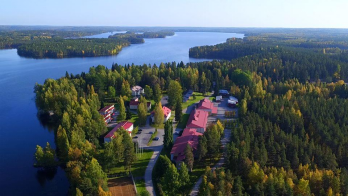
二、自然地理
1.地理条件
The city of Ähtäri is located in the southeast corner of Southern Ostrobothnia, bordering both the provinces of Central Finland and Pirkanmaa. With its forest, lake and mountain scenery, Ähtäri resembles Central Finland. In the west, Ähtäri is bordered by the Suomenselä watershed. The bedrock of Ähtäri is mainly granite. The most common type of soil is the moraine, which in places is quite rocky. There is little clay, but there is a lot of peat, especially in the Suomenselä area. There is also quite a lot of sand and sand. The most famous ridges in the city are the Big Dog Lake Harju and the Peränteen Punkaharju, which belong to the Soini side and belong to the national ridge protection program. Punkaharju is part of an intermittent ridge section that comes to the Ähtäri side from the south to Torakkakangas and continues to Perännejärvi as a rooftop, which is cut only by the narrow Kirkkosalmi. From Peränneharju, Harju continues via Vähä-Haapajärvi to Lake Liesjärvi on the side of Töysä municipality.
The surface shapes of the coffin vary. Especially in the Suomenselä area on the west side of Lake Ähtärinjärvi, the terrain is uneven. Steep hills, bordered by gorge-like valleys, rise to a height of over 200 meters. The areas to the east and south of Lake Ähtärinjärvi are also sublime and variable, although the differences in altitude are not as significant as in the west. The highest elevations in Ähtäri are the hills surrounding Ohraneva and Murtomäki in the north, Hiironmäki on the eastern border and Koiramäki on the western border. Forests cover three-quarters of the city’s land area. The field is just over six percent. Call is highest in the eastern parts of the city. Loukkusuo and Iso and Pieni Tupasuo in the south-east have been taken into peat production.
2. 交通情况
Highway 18 from Jyväskylä to Vaasa and main road 68 from Virra to Pietarsaari pass through Ähtäri. The travel time between Helsinki and Ähtäri takes a maximum of four hours by train and four hours and 25 minutes by direct bus. There are direct train connections from Ähtäri to Jyväskylä, Seinäjoki and Tampere.
The nearest airports are located about 75 kilometers from Ähtäri in Ilmajoki, about 115 kilometers from Jyväskylä and about 145 kilometers from Pirkkala.
三、经济发展和规模
Based on the consolidated financial statements for 2015 and 2016, Ähtäri meets the crisis criteria according to the new Municipal Act. However, in February 2017, an assessment team under the crisis management procedure estimated that Ähtäri could continue as an independent municipality, and Ähtäri's crisis status was removed.The Municipal tax rate of Ähtäri is around 20.75%. The companies that paid the most corporate tax in 2016 were Muovilami Oy, which manufactures reinforced plastic doors, Tankki Oy, which produces tanks for industry, and Katutekno Oy, which makes repairs and repairs to asphalt surfaces.
四、产业特点/重点项目
The Ähtäri region had no permanent settlement before the late Middle Ages. The wilderness was divided for hunting, fishing and birch burning to peasants from Satakunta and Häme. The important tar economy in Southern Ostrobothnia did not strengthen in Ähtäri until the 19th century. Nowadays, Services, business Ähtäri's rapids, water bodies and large forest resources have enabled the diverse development of livelihoods. Vitality is created not only by the ever-evolving tourism, but also by a strong metal industry.
Ähtäri is known for its zoo and hotel Mesikämmen designed by Timo and Tuomo Suomalainen which is partly built within bedrock. The biggest lake in the area is Ähtärinjärvi. There is also a relatively old and small board mill called Vääräkosken Pahvi in Ähtäri.
Ähtäri is located on the border of three provinces in the middle of the most magnificent Finnish lake landscape. A water-rich place known for tourism, it is also the center of European aluminum boat production.
五、风景名胜,景点( attractions)
1. Ähtäri Zoo
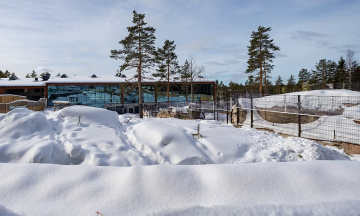
Ähtäri Zoo is a 60-hectare (150-acre) zoo in Ähtäri, Finland that was opened in 1973. It is the second largest zoo in Finland, and is a member of the European Association of Zoos and Aquaria (EAZA). Köpi the moose was the first animal at the zoo. After several years, wolves and lynxes were added. However the zoo's most famous residents are probably the bears, Santeri and his mate Santra, who have lived at the zoo almost since its founding. In 2003 the Korkeasaari Zoo in Helsinki gifted snow leopards to Ähtäri Zoo for their 30th anniversary. By 2006 there were 65 animals, mostly from the coniferous zone. In 2018, two giant pandas have arrived from China.
2. Flowpark Ähtäri Zoo
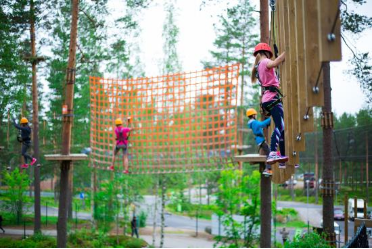
Flowpark is an ecological adventure park where you can test your courage. Adventure courses have been built on living trees without harming them. You may solve numerous tasks even at a height of twenty meters. Different tasks refer to ropeways, including swaying paths, liana jumps, swings and cable slides. Every Flowpark is unique, so there are no two identical courses. Flowpark has been meant for people of all ages full of adventure spirit – there is a challenge for any ordinary guy as well as for experienced ‘wilderness foxes’!
3. Pirkanpohjan taidekeskus, Eero Hiirosen kokoelma / Pirkanpohja Artcenter, Eero Hiironen Collection
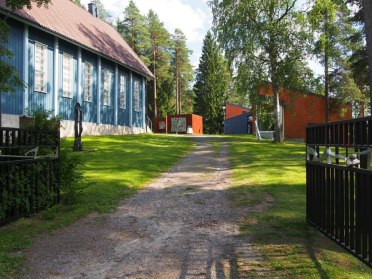
Pirkanpohja Art Center is an art museum located in Ähtäri. It was founded by sculptor Eero Hiironen in 1974. The art center consists of two buildings and the surrounding sculpture park. The oldest building in the Art Center is called the Blue House. It was designed by architect Elsi Borg, whose other well-known works include Lastenlinna in Helsinki, Taulumäki Church in Jyväskylä and Teuva Church. The Blue House was originally completed in 1934 as your parish center in Ähtäri, but since 1974 it has been the exhibition space of the art center. The art center expanded in the 1990s when the Red House was built next to the Blue House. It contains four contemporary exhibition rooms, one of which serves as a sculpture hall presenting Eero Hiironen's works of art. Eero Hiironen's sculptures are also on display in the sculpture park surrounding the Blue and Red Houses.
4. Ähäri Church
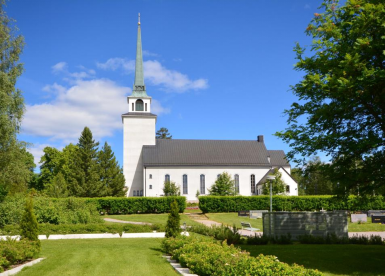
Ähäri Church was designed by architect Bertel Liljequist, and built in 1937.
六、历史文化
1.历史
Stone Age settlements have been found in the Ähtäri area in Lopet and Akkosaari. Prior to 2016, the National Board of Antiquities' registers contained a total of 95 sites from Ähtäri, and a preliminary study in 2016 found more. The name Ähtäri probably starts from between the Stone Age and the settlement-era settlement. At that time, a small Sámi population roamed the area, which has a clear impact on the Ähtär nomenclature. However, the name of the Great Lake and later the entire municipality may not be of Sámi origin, although there is a suitable counterpart in Sodankylä, Ätsärijoki. Consensus on the origin of the name has not been reached. The intersections have been seen with the Estonian word ace ‘flower, inflorescence’ (which the annotation also reminds in the coat of arms of the keeper) and the Swedish word ed ‘taival’ (of which edsjö → Etseri). The sound connection has also been noticed in the quality words grumpy and drunk, which connection is also known from Äetsä. As for Ätsäjärvi, Ätsäri has meant, Ähtäri is originally the name of the water body in any case.
The first mention of settlement in Ähtäri is in the 1589 land inspection book. Alastaipale was village-like, and there were also settlements in Peränte, Ouluvesi, Hankavesi and Vehu. The settlers of Ähtäri were farmers who quickly cleared the arable land into fields. Instead, tar was burned only for domestic use.
Ähtäri belonged to the parish of Ruovesi, founded in 1565. The journey to the church was a long one. The founding document of our own church dates from 1651. The first chapel was built on Hankolanmäki, where the current, fourth church building from 1937 also stands.
Ähtäri remained very sparsely populated throughout the time it belonged to Sweden. This was influenced by repeated roof years and famines during the cold period of the 1570s, known as the Little Ice Age, the year 1601 remembered as the Great Straw Year, the 18th century roof years 1633, 1648–50, 1657 and especially 1666–68 (Lauri’s frost years). more than a quarter of a million people and another 1697 (a great year of death). Instability was also caused by constant warfare. The great power Sweden invaded Germany once, the Baltic. The Thirty Years' War was fought from 1618 to 1648. In the Great Northern War, Sweden's superpower status collapsed. After Charles XII was defeated in the Battle of Poltava in 1709. Russia's military operations were directed at Finland, and Russian danger reached Ostrobothnia. The occupation period began, great anger. Ähtäri was a remote place out of reach of significant road connections. After the Battle of Pälkäne in 1713, when the escape of Swedish troops began, Ähtäri also showed fleeing soldiers. However, the retaliation also indirectly affected Ähtäri. To quell the resistance, the Russians imprisoned almost all the officials. There was only one priest left in the whole large congregation, Johannes Collinus, the chaplain of Ähtäri.
2. 文化
The Ähtäri region had no permanent settlement before the late Middle Ages. The wilderness was divided for hunting, fishing and birch burning to peasants from Satakunta and Häme. They cultivated the land in their homeland in the summer, but made fishing trips to these wilderness areas in the winter. The system was dismantled in 1552 by a batch reduction. After that, the barren Suomenselä also began to become permanent settlements: in addition to the owners of the Pirkkala wilderness rights, Savoans and, most recently, Ostrobothnians. The Ähtäri chapel initially consisted of only 27 houses. Chapel boundaries were arranged according to how the church people walked along the waterways.
Ähtäri was also involved in the 1700 second half of the century wars, but they were not in the place of the very significant. Instead, the Finnish War of 1808–1809 also directly affected Ähtäri. The Battle of Myllymäki was waged in the municipality on August 20, 1808. The clash of Myllymäki was a sequel to the Battle of Alavus (August 18). The Russians retreating from the lower reaches Keuruu via Ähtäri and Myllymäki. The Finnish department sent after them first accompanied the fugitives in Inha, at the Nääsi Strait and again in the Myllymäki war ear. Skeletons, cannonballs and stabs have since been found in the terrain of Sotakorvi, but no actual excavations have been made in the area. A sword was found along the Talvitie in Keuruu and is kept in the Ähtäri Homeland Museum.
七、其他信息
Ähtäri has a common open wireless LAN, Kuusiokunta. Ähtäri also belongs to the operating area of the network cooperative Kuuskaista, a commercial fiber optic network operating in Kuusiokunti.
Notable individuals in the Ähtäri history:
Anton Collin, cross country skier and road cyclist
Eero Hiironen, sculptor and painter
Kari Hirvonen, lead singer of Tango King
Aki Hintsa, sports physician and orthopedic surgeon
Toivo Korpela, preacher and speaker; fervent Laestadian and founder of the Korpela movement
Niko Korsumäki, Snowcrossing World Championship bronze medalist
Esa Latva-Äijö, actor
Veikko Mattila, Member of Parliament
Matti Pekkanen, engineer and politician
Emanuel Pohjaväre, Member of Parliament
Mikko Savola, Member of Parliament
Topi Sorsakoski, musician
Antti Tammilehto, musician
Seppo Tammilehto, musician
Edvard Valpas-Hänninen, former chairman of the Social Democratic Party of Finland
八、联系方式

Mayor of Ähtäri: Jarmo Pienimäki
Address:Ostolantie 17, 63700 Ähtäri
Phone number: 06 2525 6000
Email: kirjaamo@ahtari.fi
Facebook: facebook.com/ahtarinkaupunki
Website: https://www.ahtari.fi/
